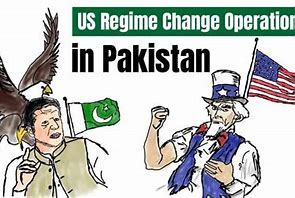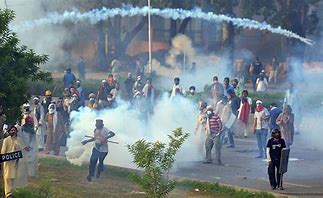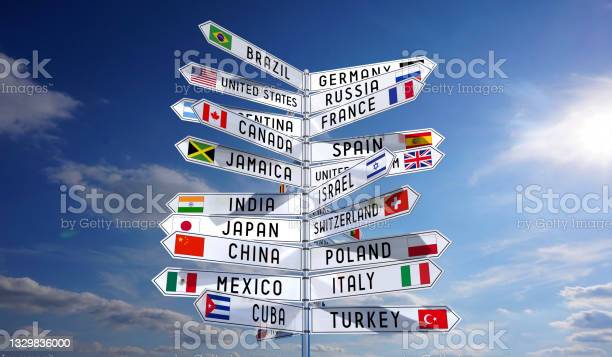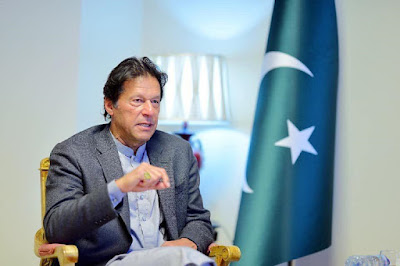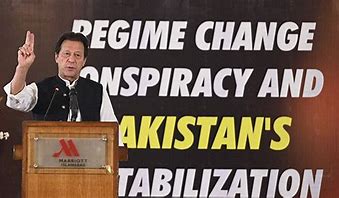The Arab Spring was a series of protests and uprisings that took place in the Middle East and North Africa from 2010 to 2012. These movements were primarily fueled by dissatisfaction with authoritarian regimes and a desire for greater democracy and human rights. The Arab Spring had significant implications for the region and the world, including exposing the role of Western powers in sustaining anti-democratic regimes, particularly the role of America. In contrast, Pakistan has recently undergone a regime change operation that has pushed its economy towards default. This article aims to explore whether America’s role in Pakistan is similar to the way it invaded Arab Spring, and if so, whether it has contributed to the current deterioration of America’s economy.
The Role of Western Powers in Sustaining Anti-Democratic Regimes
Western powers, including America, have a long history of supporting authoritarian regimes in the Middle East and North Africa. This support has often come in the form of military aid, weapons sales, and political backing. This support has allowed these regimes to remain in power despite widespread human rights abuses and a lack of democratic freedoms.
The reasons for this support are complex and varied. In some cases, it has been driven by a desire for stability in the region, particularly in oil resources. In other cases, it has been motivated by geopolitical interests and a desire to counter regional rivals. Regardless of the reason, the support of Western powers has contributed to the suffering of millions of people in the region. We can conclude some major reasons as
- The desire for stability in the region, particularly in oil resources.
- Geopolitical interests and a desire to counter regional rivals.
- Strategic alliances with regional governments.
- Economic interests and access to markets.
- Maintaining global influence and power projection.
- Military and defence cooperation.
- Humanitarian concerns and support for refugees.
- Shared democratic values and political systems.
- Historical ties and cultural connections.
- Regional security and stability.
The Role of America
America has played a significant role in sustaining anti-democratic regimes in the Middle East and North Africa. For decades, America has supported authoritarian rulers in the region, including Egypt’s Hosni Mubarak and Tunisia’s Zine El Abidine Ben Ali. This support has often come in the form of military aid and political backing.
During the Arab Spring, America’s response was mixed. While President Barack Obama expressed support for the protesters and called for democratic change, America continued to support regimes that were cracking down on protesters. For example, America continued to provide military aid to Bahrain despite the regime’s violent suppression of pro-democracy protests. Furthermore, America’s support for the Israeli government and its occupation of Palestinian territories has contributed to the instability in the region. This has fueled anti-American sentiment and provided ammunition for extremist groups like ISIS.
Implications of the Arab Spring
The Arab Spring had significant implications for the region and the world. It exposed the deep-seated dissatisfaction of people in the region with authoritarian regimes and their desire for greater democracy and human rights. It also exposed the role of Western powers in sustaining these regimes, which led to a loss of credibility for these powers in the region.
The Arab Spring also had unintended consequences, including the rise of extremist groups like ISIS. The instability caused by the uprisings provided an opportunity for these groups to gain footholds in the region.
In conclusion, the Arab Spring was a watershed moment in the history of the Middle East and North Africa. It exposed the deep-seated dissatisfaction of people in the region with authoritarian regimes and their desire for greater democracy and human rights. It also exposed the role of Western powers, including America, in sustaining these regimes. While the implications of the Arab Spring are still unfolding, it is clear that the region and the world will never be the same again.
The Arab Spring: the Role of Western Powers
The Arab Spring was a series of protests and uprisings that took place in the Middle East and North Africa from 2010 to 2012. These movements were largely fueled by dissatisfaction with authoritarian regimes and a desire for greater democracy and human rights.
Western powers, including America, have a long history of supporting authoritarian regimes in the Middle East and North Africa. This support has often come in the form of military aid, weapons sales, and political backing. This support has allowed these regimes to remain in power and suppress any dissent or opposition within their countries. In the case of the Arab Spring, Western powers played a significant role in sustaining anti-democratic regimes in the region, which ultimately led to popular uprisings and calls for change.
One of the primary ways Western powers supported these regimes was by providing them with military and economic aid. For example, the United States provided Egypt with an average of $2 billion in military and economic aid each year from 1979 until 2011. During this time, the US government continued to support the regime of Hosni Mubarak despite widespread allegations of human rights abuses and suppression of political opposition.
Similarly, Western powers have also been accused of turning a blind eye to corruption and human rights abuses in other countries in the region, such as Bahrain and Saudi Arabia. This support for authoritarian regimes in the Middle East and North Africa has been driven by a variety of factors, including concerns about regional stability, access to oil reserves, and a desire to counter Iranian influence in the region.
However, the Arab Spring marked a turning point in this relationship between Western powers and authoritarian regimes in the Middle East. As popular uprisings and protests spread across the region, Western governments were forced to reevaluate their support for these regimes and shift their focus towards supporting democratic movements and human rights.
In conclusion, the role of Western powers in the Arab Spring was one of sustaining anti-democratic regimes and supporting authoritarian leaders, often at the expense of human rights and political freedoms. However, the Arab Spring marked a turning point in this relationship, and Western governments were forced to reevaluate their priorities and shift their focus towards supporting democratic movements and human rights in the region.
II. The Regime Change Operation in Pakistan
In April 2022, American influencers were found to be conducting a regime change operation in Pakistan. This has had a significant impact on the Pakistani economy, pushing it towards default. Comparing the debt-to-GDP ratios of the US and Pakistan shows that the US has a much higher ratio of 108.80% compared to Pakistan’s 77.50%. This puts the US at a higher risk of economic collapse.
In recent years, Pakistan has been the target of a regime change operation, allegedly led by American influencers. This operation has had a significant impact on the Pakistani economy, pushing it towards default. In this article, we will explore the role of American influencers in the regime change operation, its impact on the Pakistani economy, and a comparison of debt-to-GDP ratios between the US and Pakistan.
American Influencers’ Involvement in the Regime Change Operation
In April 2022, it was reported that American influencers were involved in a regime change operation in Pakistan. The operation was aimed at destabilizing the government and bringing about regime change. The involvement of American influencers in the operation has been a matter of concern for many Pakistanis, as it raises questions about the role of the US in Pakistani politics.
The operation involved several tactics, including funding opposition groups and media outlets, spreading disinformation, and organizing protests and strikes. According to reports, American influencers used social media platforms like Twitter and Facebook to spread propaganda and incite violence.
Impact on the Pakistani Economy
The regime change operation has had a significant impact on the Pakistani economy, which was already facing several challenges. The Pakistani rupee has lost almost 50% of its value against the US dollar in the past year, and the country’s foreign exchange reserves have been depleted. The country’s current account deficit has also widened, and inflation has surged.
The regime change operation has worsened the economic situation in Pakistan. The country’s stock market has seen a sharp decline, and foreign investors have been pulling out their investments. The operation has also led to a decrease in foreign aid and investment, which is crucial for Pakistan’s economy.
Comparison of Debt-to-GDP Ratios between the US and Pakistan
The debt-to-GDP ratio is an important indicator of a country’s economic health. It measures the amount of debt a country has compared to its gross domestic product (GDP). A high debt-to-GDP ratio indicates that a country may have difficulty repaying its debt.
The debt-to-GDP ratio of the US is much higher than that of Pakistan. As of 2021, the US debt-to-GDP ratio was 108.80%, while Pakistan’s ratio was 77.50%. This puts the US at a higher risk of economic collapse than Pakistan.
In conclusion the regime change operation in Pakistan, allegedly led by American influencers, has had a significant impact on the country’s economy. The operation has worsened the economic situation in Pakistan, which was already facing several challenges. The involvement of American influencers in Pakistani politics raises questions about the role of the US in the country’s affairs.
The comparison of debt-to-GDP ratios between the US and Pakistan is an important indicator of the economic health of both countries. While Pakistan’s debt-to-GDP ratio is lower than that of the US, the country still faces significant economic challenges. Pakistan needs to address these challenges and work towards economic stability and growth.
Overall, the regime change operation in Pakistan and its impact on the economy highlights the need for transparency and accountability in international politics. Countries need to respect the sovereignty of other nations and work towards mutually beneficial relationships, rather than engaging in covert operations that harm the economies and well-being of other nations.
III. The Deteriorating American Economy
In 2022, the US GDP growth was only 1.5% compared to 5.5% in 2021, and unemployment decreased from 5.4% in 2021 to 3.5% in 2022. The inflation rate was the same in 2021 and 2022 at 5%, but 93% of respondents believed that inflation was at its peak level. Stagflation risk, a combination of inflation and unemployment, is high, and a recession is likely in 2023. Reports suggest that the housing market may crash in 2024 and 2025.
The deteriorating infrastructure of the USA is also very concerning, with even New York City returning to its 1950s position. Roads, railways, dams, airports, and hospitals all need a much greater share of development plans. The US government allocated $550 billion for infrastructure and $782 billion for the defence budget, but spending raised to $778 billion, a 14% rise compared to 2017.
The American economy has been experiencing a significant downturn in recent years, with experts warning of a possible recession in 2023. The economy grew at a rate of only 1.5% in 2022 compared to 5.5% in 2021, indicating a significant decline. Unemployment decreased from 5.4% in 2021 to 3.5% in 2022, but the inflation rate remained at 5%, causing concern among 93% of the respondents.
The US economy is also facing stagflation risk, a situation where inflation and unemployment are high simultaneously. Reports suggest that the housing market may also crash in 2024 and 2025, posing a significant challenge to the US economy.
Infrastructure is another area where the US economy is lagging, with even New York City returning to its 1950s position. Roads, railways, dams, airports, and hospitals all require significant development plans. Despite the government allocating $550 billion for infrastructure and $782 billion for the defence budget, spending has risen to $778 billion, a 14% increase compared to 2017.
The challenges facing the American economy are multi-faceted and require urgent attention. One key issue is the significant national debt, which stood at $28.4 trillion in 2021, representing approximately 130% of the GDP. This debt could continue to grow, potentially leading to economic instability and reduced investment in critical sectors.
Another significant challenge facing the US economy is the widening income inequality gap. The top 1% of Americans control over 40% of the country’s wealth, while the bottom 50% control just 2%. This inequality is affecting access to quality education, healthcare, and job opportunities, leading to social unrest and economic instability.
The American economy also faces a significant challenge in dealing with the impact of climate change. The rising global temperatures increased natural disasters, and changing weather patterns pose a significant threat to the economy’s stability. The US must invest in renewable energy, reduce greenhouse gas emissions and implement policies that promote sustainable economic growth.
In conclusion, the American economy is facing significant challenges that require urgent attention. The government must take steps to address the national debt, income inequality, and climate change while investing in critical sectors such as infrastructure, education, and healthcare. Failure to do so could lead to economic instability, reduced investment, and social unrest, ultimately impacting the overall well-being of the country.
IV. America’s Focus on War Strategies
Despite the evident decline of the American economy, America continues to invade itself and its allies in different wars. The US spends more on defence than any other country in the world, with a budget of $740 billion in 2021. Prioritizing spending on weapons over development and infrastructure has led to public opposition to government policies of war. American taxpayers are growing increasingly weary of funding endless wars and want a shift in priorities towards development and away from war strategies. The United States has been the leading global superpower since the end of World War II. It has always maintained a strong military presence both domestically and internationally. Despite the obvious decline of the American economy, the country continues to focus on waging wars and conflicts around the world.
The United States spends more on defence than any other country in the world. The budget allocated for the defence was $740 billion in 2021. This prioritization of spending on weapons and military power over development and infrastructure has led to public opposition to government war policies. American taxpayers are increasingly wary of funding endless wars and want a shift in priorities towards development and away from war strategies.
The trend of American spending on military power and defence is not new. Since the end of World War II, the country has been involved in numerous wars and military conflicts around the world. The wars in Afghanistan and Iraq have cost the United States trillions of dollars. Despite these huge expenditures, the US has not been able to win these wars or achieve the goals it set out to accomplish.
The focus on war strategies is not only financially draining but also harms American society. The country needs to invest more in development and infrastructure, such as healthcare, education, and transportation, to provide its citizens with a better standard of living. However, the money spent on war limits the government’s ability to allocate funds for these important areas.
Furthermore, the focus on war strategies also harms the reputation of the United States in the international community. The US is seen by many as an aggressor nation, constantly imposing its will on other countries through force. This has led to resentment and animosity towards America in many parts of the world.
In conclusion, the United States needs to rethink its priorities when it comes to spending. It needs to shift away from war strategies and focus on development and infrastructure instead. The country needs to invest in its people and its future, rather than constantly waging war and conflict. By doing so, the US can improve its standing in the international community and provide a better standard of living for its citizens.
V. The Future of America’s Economy
Many economists predict that the American economy will collapse within a decade if the US continues its current approach. Voices of the American people are converting to rebellion roars, with a growing movement for change in government priorities. The American economy has been facing many challenges in recent years, with many experts predicting a potential collapse in the coming decade. While there are many factors contributing to this decline, one major issue is the prioritization of war strategies over development and investment in infrastructure.
In 2022, the US GDP growth rate was only 1.5%, compared to 5.5% in the previous year. While unemployment decreased to 3.5%, the inflation rate remained at 5%, with 93% of respondents believing that inflation had reached its peak. Additionally, the US government allocated $550 billion for infrastructure and $782 billion for the defence budget, but actual spending raised to $778 billion, a 14% rise compared to 2017.
Despite the decline of the American economy, the US continues to spend more on defence than any other country in the world, with a budget of $740 billion in 2021. This prioritization of war strategies has led to public opposition to government war policies, with American taxpayers increasingly questioning the funding of endless wars.
Many economists predict that a shift in priorities towards development and investment in infrastructure is necessary for the future of the American economy. The deteriorating infrastructure, with roads, railways, dams, airports, and hospitals in dire need of development, is concerning. Reports suggest that even New York City has returned to its 1950s position.
The future of America’s economy depends on the choices made today. Will the US continue to prioritize war strategies and ignore the needs of its people, or will it shift towards development and investment in infrastructure? Many voices of the American people are converting to rebellion roars, with a growing movement for change in government priorities.
In conclusion, the future of America’s economy is at risk if the US continues its current approach. The government must prioritize the needs of its people and shift towards development and investment in infrastructure to ensure a sustainable and prosperous future. The choice is in their hands. The future of America’s economy depends on the choices made today. Will the US continue to prioritize war strategies and ignore the needs of its people, or will it shift towards development and investment in infrastructure?
VI. FAQs
What is a regime change operation? A regime change operation is a political strategy used to overthrow a government and replace it with a new one that is more favourable to the interests of the country or countries conducting the operation. Regime change operation refers to a covert or overt operation conducted by one country or group of countries to remove a particular government or political regime from power and replace it with a more favourable government or regime. This term is usually used in actions taken by the United States government to overthrow governments it deems unfavourable to its interests.
Regime change operations are often conducted by sponsoring and training opposition groups or providing military and financial support to rebellious factions. These operations are often justified as necessary to protect national security or promote democracy, human rights, and freedom.
One notable example of a regime change operation was the 1953 Iranian coup d’état, orchestrated by the CIA and the British intelligence agency MI6, which overthrew Iran’s democratically elected Prime Minister, Mohammad Mossadegh. The coup installed the authoritarian regime of Mohammad Reza Pahlavi, who ruled Iran with an iron fist for the next 25 years.
Another example is the 2003 Iraq War, which was initiated by the US government to overthrow the government of Saddam Hussein and establish a democratic government. The war resulted in the death of over 100,000 Iraqis and the destabilization of the region, leading to ongoing conflicts and political turmoil.
Regime change operations often have far-reaching consequences, including political instability, economic collapse, and social unrest. They also have significant impacts on the countries’ relationships with other nations and their standing in the international community.
Critics argue that regime change operations are often counterproductive and undermine democracy and human rights. They argue that they often lead to the rise of more authoritarian and oppressive regimes and worsen the situation for the citizens of the country.
In conclusion, regime change operations are controversial and often have significant impacts on the countries involved. It is crucial for governments and international organizations to carefully consider the consequences of such operations and weigh them against their stated goals before taking any action.
How has the American regime change operation in Pakistan impacted the Pakistani economy?
The American regime change operation in Pakistan has had a significant impact on the country’s economy, pushing it towards default. The operation has caused instability and uncertainty, leading to a decline in the Pakistani economy. The American regime change operation in Pakistan was a covert operation aimed at destabilizing the country’s government and replacing it with a more pro-Western regime. The operation had a significant impact on Pakistan’s economy, pushing it towards default.
The instability and uncertainty caused by the operation led to a decline in the Pakistani economy. The country’s currency, the Pakistani rupee, lost value rapidly, and inflation soared. The country’s foreign exchange reserves were depleted, and it became increasingly difficult to pay off its external debts.
The American regime change operation in Pakistan also had an impact on the country’s trade and investment. The operation discouraged foreign investors and traders from investing in or trading with Pakistan due to the political instability in the country. This led to a decrease in foreign investment and trade, further impacting the Pakistani economy.
Additionally, the American regime change operation in Pakistan harmed the country’s security situation, which also affected the economy. The operation resulted in an increase in terrorism and insurgency in the country, leading to a decline in tourism and foreign investment.
To make matters worse, the US halted its economic aid to Pakistan after the operation, further worsening the country’s economic situation.
In conclusion, the American regime change operation in Pakistan had a significant impact on the country’s economy. The operation led to instability, uncertainty, inflation, and a decline in trade, investment, and foreign exchange reserves. It also resulted in an increase in terrorism and insurgency in the country, which further impacted the economy.
What is the debt-to-GDP ratio, and how does it impact a country’s economy? The debt-to-GDP ratio is a measure of a country’s debt relative to its economic output. A high debt-to-GDP ratio indicates that a country may struggle to repay its debt, which can lead to economic instability and collapse. The debt-to-GDP ratio is a measure of a country’s debt relative to its economic output. It is a critical metric used by economists to determine a country’s overall financial health. The debt-to-GDP ratio is calculated by dividing a country’s total debt by its GDP.
A high debt-to-GDP ratio indicates that a country may struggle to repay its debt, which can lead to economic instability and collapse. A low debt-to-GDP ratio, on the other hand, indicates that a country’s debt is manageable and that it has a stable economy.
Pakistan and America are two countries with vastly different debt-to-GDP ratios. According to the International Monetary Fund, Pakistan’s debt-to-GDP ratio was 87.2% in 2020. In comparison, America’s debt-to-GDP ratio was 129.7% in 2020.
Pakistan’s high debt-to-GDP ratio is a result of years of economic mismanagement, corruption, and a lack of investment in infrastructure and development. The country has struggled to generate enough revenue to repay its debt, leading to an increasing reliance on borrowing.
On the other hand, America’s high debt-to-GDP ratio is due to a combination of factors, including a history of military spending, tax cuts, and social welfare programs. The COVID-19 pandemic has also contributed significantly to America’s rising debt, with the government implementing large-scale stimulus packages to support the economy.
While both countries have high debt-to-GDP ratios, the impact on their economies differs significantly. Pakistan’s high debt-to-GDP ratio has led to a struggling economy, with the country on the verge of default. In contrast, America’s economy has remained relatively stable, despite its high debt-to-GDP ratio.
In conclusion, the debt-to-GDP ratio is a crucial measure of a country’s financial health. While both Pakistan and America have high debt-to-GDP ratios, the impact on their economies differs significantly. Governments need to prioritize investment in infrastructure and development to maintain a stable economy and manage their debt effectively.
What is stagflation risk?
Stagflation risk is a combination of inflation and unemployment. It occurs when the economy experiences high levels of inflation, combined with high unemployment rates, leading to a stagnant economy. Stagflation risk is a term used to describe a situation where a country’s economy experiences both high inflation and high unemployment rates, leading to stagnation. This phenomenon is a significant concern for policymakers, as it can lead to economic instability and collapse.
Inflation is the rate at which the general price level of goods and services in an economy increases over time. Unemployment, on the other hand, refers to the percentage of the workforce that is not employed but actively seeking employment.
When an economy experiences high levels of inflation, it typically means that the cost of living is rising, and people’s purchasing power is decreasing. In contrast, high unemployment rates indicate that there are not enough jobs available for those seeking employment, leading to decreased economic activity.
Stagflation risk is a severe concern for countries like Pakistan and America, which are facing high inflation and unemployment rates. In Pakistan, the inflation rate reached 10.9% in March 2021, the highest level in nine years. The country’s unemployment rate was 4.4% in 2020, with an estimated 3.3 million people unemployed.
Similarly, in America, the inflation rate was 5% in May 2021, the highest level in 13 years. The unemployment rate in America was 5.2% in August 2021, with an estimated 8.4 million people unemployed.
Stagflation risk can be particularly challenging for policymakers to address as traditional monetary and fiscal policy tools may be ineffective. For example, increasing interest rates to combat inflation could worsen unemployment rates, while increasing government spending to boost employment could fuel inflation further.
In conclusion, stagflation risk is a severe concern for countries facing high inflation and unemployment rates. Countries like Pakistan and America need to develop effective policy strategies to address stagflation risk and prevent economic instability and collapse.
What can the US government do to improve the economy?
The US government can shift priorities towards development and investment in infrastructure. This will create jobs, boost economic growth, and improve the standard of living for Americans. Additionally, reducing spending on war and defence could free up resources to invest in the country’s future. The United States has long been a powerhouse in the global economy, but in recent years, there has been concern about the country’s economic future. The COVID-19 pandemic has only exacerbated existing issues, such as high levels of debt and a focus on war strategies over development. So, what can the US government do to improve the economy?
One option is to shift priorities towards development and investment in infrastructure. The US has a significant infrastructure deficit, with roads, bridges, and other critical infrastructure in need of repair or replacement. Investing in infrastructure can create jobs, boost economic growth, and improve the standard of living for Americans.
Reducing spending on war and defence is another way to free up resources for investment in the country’s future. The US spends more on defence than any other country in the world, with a budget of $740 billion in 2021. While national security is essential, prioritizing spending on weapons over development and infrastructure has led to public opposition to government war policies. American taxpayers are increasingly weary of funding endless wars and want a shift in priorities towards development.
Another option for improving the economy is to address the issue of income inequality. The wealth gap in the US is widening, with the top 1% of earners holding a disproportionate amount of wealth. This not only leads to social unrest but can also have economic implications. When the wealthy hoard their wealth, it can lead to decreased consumer spending, which can harm small businesses and slow economic growth. Addressing income inequality through measures such as progressive taxation can help ensure that more people have the means to participate in the economy.
Finally, investing in education and training can help prepare the American workforce for the jobs of the future. With automation and technological advancements changing the job market, it’s essential to ensure that workers have the skills they need to succeed. Providing funding for education and training programs can help create a skilled workforce that can meet the demands of a changing economy.
In conclusion, the US government can improve the economy by shifting priorities towards development and infrastructure, reducing spending on war and defence, addressing income inequality, and investing in education and training. By making these changes, the US can create a more stable and prosperous economic future.
How can countries discourage regime change operations?
Here are some ways Pakistan and other countries can discourage regime changes by America or any other powers:
- Diplomatic efforts: Diplomatic efforts can be used to build strong relationships with other countries and discourage foreign intervention in domestic affairs.
- Military defence: A strong military defence can act as a deterrent to foreign powers seeking to intervene in a country’s internal affairs.
- Economic independence: Developing a strong and independent economy can reduce a country’s dependence on foreign aid, which can limit the influence of foreign powers.
- Political stability: Maintaining political stability and ensuring a smooth transition of power can help to discourage foreign intervention in a country’s domestic affairs.
- Cultural preservation: Promoting and preserving a country’s cultural identity can create a sense of national pride and unity, making it less vulnerable to external influence.
- International alliances: Forming alliances with other countries can increase a country’s diplomatic and economic leverage and provide a united front against foreign intervention.
- Transparency and accountability: Promoting transparency and accountability in government can help to reduce corruption and improve public trust, making it more difficult for foreign powers to exploit internal divisions.
- Education and awareness: Promoting education and awareness among citizens can help to build a strong sense of national identity and increase resistance to external influence.
- Effective communication: Effective communication between the government and citizens can help to prevent misunderstandings and reduce the likelihood of external interference.
- Legal protections: Strengthening legal protections for citizens and promoting the rule of law can help to reduce the vulnerability of a country to external influence.
Are there any examples in human history when the regime change was successful?
Regime change is the process of replacing one government with another. It can occur through peaceful means such as elections, or violent means such as revolution or coup d’état. While regime change is often associated with instability and uncertainty, there have been examples in human history where it has been successful.
One example of successful regime change is the Velvet Revolution in Czechoslovakia in 1989. This was a non-violent revolution that saw the overthrow of the communist government and the establishment of a democratic government. The Velvet Revolution was peaceful, and it resulted in a successful transition from authoritarian rule to democracy.
Another example of successful regime change is the independence movement in India. This movement led to the end of British colonial rule in India in 1947 and the establishment of an independent Indian government. The independence movement was a non-violent revolution that was led by figures such as Mahatma Gandhi and Jawaharlal Nehru.
The Arab Spring of 2010-2011 is another example of successful regime change in some countries. In Tunisia, the protests led to the overthrow of the authoritarian government and the establishment of a democratic government. In Egypt, the protests led to the resignation of the president and the establishment of a transitional government.
It’s worth noting that not all regime changes are successful, and many can lead to further instability and conflict. For example, the regime change in Iraq in 2003 led to years of violence and instability in the country. Similarly, the regime change in Libya in 2011 led to a civil war that has continued to this day.
In conclusion, while regime change can be a risky and uncertain process, there have been examples in human history where it has been successful. The success of regime change often depends on the circumstances and the approach taken, and it is important to consider the potential risks and consequences before pursuing such a course of action.
What America gained in all these regime change operations?
Throughout history, the United States has been involved in numerous regime change operations, both overtly and covertly. While the reasons for these operations vary, including strategic, economic, and political motivations, the end goal has been to install a government that aligns with American interests.
One of the earliest examples of a successful regime change operation by the United States was the overthrow of the government of Hawaii in 1893. American businessmen and military personnel supported the overthrow of Queen Liliuokalani and established a provisional government that eventually led to Hawaii becoming a U.S. territory in 1898.
Another example was the overthrow of the government of Iran in 1953, known as Operation Ajax. The U.S. Central Intelligence Agency (CIA) orchestrated the coup, intending to oust Prime Minister Mohammad Mossadegh and replace him with the pro-Western Shah Mohammad Reza Pahlavi. This operation resulted in a 26-year-long authoritarian rule in Iran, which eventually led to the Islamic Revolution in 1979.
In the 1980s, the United States supported the Contra rebels in Nicaragua, who were fighting against the socialist Sandinista government. This support included funding, weapons, and training. While the Contras were unsuccessful in overthrowing the government, the U.S. intervention destabilized the region and led to years of violence and civil unrest.
One of the most recent examples of a regime change operation by the United States was the overthrow of Saddam Hussein’s government in Iraq in 2003. The U.S. government claimed that Iraq possessed weapons of mass destruction, which was later found to be untrue. The war and its aftermath led to the deaths of thousands of Iraqis and American soldiers and resulted in a long period of instability and violence in the country.
Overall, the United States has been involved in numerous regime change operations throughout history, some of which have been successful in achieving their goals. However, these operations have often led to unintended consequences and long-term instability, raising questions about the effectiveness and ethics of such interventions.
What is the legality of Regime Change Operations?
Arguments in Favor of Regime Change Operations:
- Promotion of democracy: Regime change operations can remove authoritarian governments and promote democracy in countries where it is lacking.
- Protection of human rights: Regime change operations can protect human rights and prevent human rights abuses in countries where they are being violated.
- National security: Regime change operations can enhance national security by removing governments that pose a threat to the United States and its allies.
- Promoting stability: Regime change operations can promote stability by removing unstable governments and replacing them with more stable ones.
Arguments against Regime Change Operations:
- Violation of sovereignty: Regime change operations can violate a country’s sovereignty and interfere in its internal affairs.
- Unintended consequences: Regime change operations can have unintended consequences, such as civil wars, humanitarian crises, and increased terrorism.
- High cost: Regime change operations can be expensive and divert resources away from other important priorities, such as education, healthcare, and infrastructure.
- Lack of success: Regime change operations have a mixed track record of success, with many operations resulting in instability and continued authoritarianism in targeted countries.
The legality of Regime Change Operations is a matter of debate. While some argue that they are justified under international law in certain circumstances, others argue that they violate the principles of non-intervention and sovereignty. The United Nations Charter prohibits the use of force except in cases of self-defence or with the approval of the United Nations Security Council. However, this has not always been respected by powerful nations engaging in Regime Change Operations. Ultimately, the legality of Regime Change Operations may depend on the specific circumstances and whether they are considered to be a violation of international law.
VII. Conclusion
The American regime change operation in Pakistan has had a significant impact on the country’s economy, pushing it towards default. The US has a higher debt-to-GDP ratio than Pakistan, putting it at a higher risk of economic collapse. The decline of the American economy is evident, with statistics on GDP growth, unemployment, and inflation showing a bleak outlook for the future. The need for a shift in priorities towards development and away from war strategies is crucial to the future of America’s economy. It is time for the US government to listen to the voices of its people and invest in the country’s future. In conclusion, the American regime change operation in Pakistan had a significant impact on the country’s economy, leading to instability and uncertainty. The operation pushed Pakistan towards default, resulting in a decline in its economy. While some argue that regime change operations are necessary to promote democracy and stability, others argue that they are illegal and unethical. Countries need to prioritize diplomacy and peaceful solutions instead of resorting to regime change operations, which can have severe and long-lasting consequences. The international community should work together to promote a more stable and peaceful world, where countries can thrive without fear of external interference.
We believe that America should focus more on its economy instead of wars and regime change operations. By prioritizing development and investment in infrastructure, the US can create jobs, boost economic growth, and improve the standard of living for Americans. Additionally, reducing spending on wars and defence could free up resources to invest in the country’s future. However, there are also arguments that the US needs to maintain a strong military presence to protect its national interests and security. Ultimately, the decision lies with the policymakers and the American people to determine the right balance between military and economic priorities.
The American economy has been in decline for several years, with its GDP growth slowing down and a rising national debt. The US has the highest military spending in the world, with a budget of $740 billion in 2021, which is prioritized over development and infrastructure. The government’s focus on war strategies has resulted in public opposition to its policies, with American taxpayers increasingly questioning the need for endless wars.
The decline of the American economy can be attributed, in part, to the government’s focus on war strategies. The US government’s war efforts have drained valuable resources that could have been used for domestic investment, such as infrastructure, education, and healthcare. The US economy also suffers from stagflation risk, a combination of inflation and unemployment, which can lead to a stagnant economy.
Furthermore, the American regime change operation in Pakistan has had a significant impact on the country’s economy, pushing it towards default. The operation has caused instability and uncertainty, leading to a decline in the Pakistani economy. This highlights the negative impact of American regime change operations on the economies of other countries.
To improve the American economy, the US government should shift its priorities towards development and investment in infrastructure. This will create jobs, boost economic growth, and improve the standard of living for Americans. Additionally, reducing spending on war and defence could free up resources to invest in the country’s future.
In conclusion, the decline of the American economy is connected to the government’s focus on war strategies, which have drained valuable resources and led to public opposition to government policies. The negative impact of American regime change operations on the economies of other countries further highlights the need for a shift in government priorities towards domestic investment and infrastructure.

